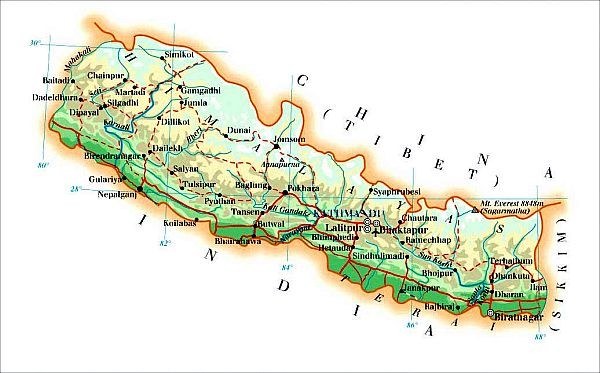Monsoon is approximately from the end of June to end of August. About 80 per cent of the rain falls during that period throughout the country but the remainder of the year is dry. Spring (March to May) and autumn (September to November) are the most pleasant seasons. Winter (December, January, and February) temperatures drop to freezing with a high level of snowfall in the high mountains. Summer, monsoon and late spring temperatures range from 28ºC (83ºF) in the hill regions to more than 40ºC (104ºF) in the Terai (southern plains). In winter, average maximum and minimum temperatures in the Terai range from a brisk 7ºC (45ºF) to a mild 23ºC (74ºF).
The central valleys experience a minimum temperature but not often falling bellow freezing point and a chilly 12ºC (54ºF) maximum. The capital ,Kathmandu Valley has a mild climate most of the year, situated at an altitude of 4,297ft (1,310m). Summer temperatures range from 67-81°F (19-27°C), and in winter temperatures are between 36 and 68°F (2-20°C). During the rainy monsoon season between June and August, there is an average rainfall of between 7.8-14.7 inches (200-375mm) in Kathmandu. May and June can be very hot and humid until the monsoon rains bring relief. In spring (March to April) and autumn (October to November) the temperatures are pleasant with occasional short bursts of rain, while November to February are dry, but can be very cold, especially at night. Best time to visit Nepal Most recommended seasons for trekking are autumn (Sept, Oct, Nov) and spring (March, April, May). In these seasons you will be rewarded by good weather, sunny and warm with clear sky and outstanding views. During monsoon (June, July, Aug) although there will be no problem for trekking, the issue could be of less visibility and rain.
But, for a keen botanist, monsoon is blessing as the higher valleys, mountains and meadows blossom with flowers and abundant vegetation. You can trek in winter (Dec, Jan, Feb) also, only the issue is cold weather with snow-fall at higher elevations. The trekking routes are crowded during spring and autumn but during monsoon and winter the routes are not packed and you could enjoy rather best of nature. However, because of effects of global warming the climate is changing world wide and there could always be possibility of exception in these weather patterns. In best seasons also there could be hoax of bad weather and sometimes even in adverse months; weather tends to be excellent for trekkers.

In Nepal, the seasons are pretty much the same as in Europe, opposite of the Australian seasons. In January it’s cold, while in July you could make do with shorts and t-shirt. The climate of Nepal is moderate which means the winters are dry and the summers are hot. But because of the huge range in altitude and landscape, climate of Nepal differs significantly throughout the country.
